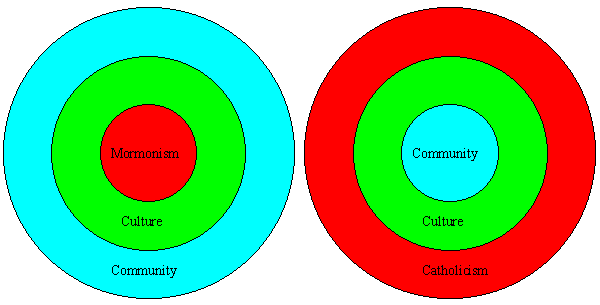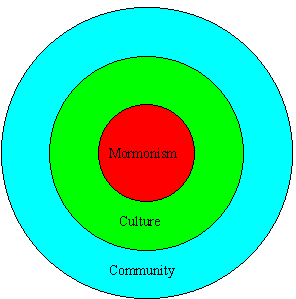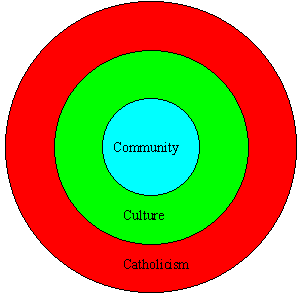What is the relationship between Religion, Culture, and Community?

The culture found in LDS community life emanates from and surrounds a religion. Having been raised within the LDS community I am deeply rooted within Mormonism and it's culture. Even though I now profess the Catholic faith I will always be Mormon just as someone from Ireland will always be Irish. Mormonism is my heritage. It defines who I am in the world and explains why my family came to live in the United States. My family members lost their "old world" heritage after joining the LDS faith and coming to America. Some of my family came here before the Revolution for various reasons but those of my family name came here because of the LDS church, having joined in England shortly after the death of Joseph Smith. Those that come to America are already at high risk of losing all cultural identity, especially those not of color. Becoming a Mormon only makes this almost inevitable loss of cultural identity certain by creating a new culture to fill in what you give up from the community or country of your birth.
Culture and community is why it is so hard to leave Mormonism, especially if you have grown up in it; Mormonism defines your culture and your community. My wife's family had lost their culture after living here in America for over 100 years. She converted to Catholicism as a child with her Mom and sisters but this I believe was part of a search for a way of life, for a culture in a country that doesn't have a definitive culture. Her older sisters met the LDS missionaries about five years later and found that the LDS offered what they believed was a better way of life and her family embraced Mormonism. My wife has been LDS since she was 9 years old. She loves the LDS culture, the visiting teaching, the Primary Organization and the Relief Society fellowship. She reads every Ensign cover to cover especially the Conference talks. For scripture, she only reads the Book of Mormon. She has no interest in doctrine or its development. She believes she has everything necessary to raise the children and to become happy in this life and in the life to come. Her goal as a teenager was to marry someone who had deep roots in the LDS faith, someone who was part of the culture and the community. She never really felt like she had been fully accepted by the LDS community, especially since her father was not at that time a member of the church. The stigma of having a non-member father and an inactive Mom and brothers was something she could feel, something that my own family held against her when I told them that I had asked her to marry me. Yes, by marrying me, she felt that she would finally be accepted into the culture that she had fully embraced as a youth. Perhaps you can try to imagine her sense of loss and fear when I became a Catholic. What would happen to our relationship? What would happen to our family? How would she be accepted by the community now that she was once again in a part-member family?
Those that quickly dismiss problems and conflicts within LDS doctrine (I did this for 40 years!) do so to protect their culture, their community, their way of life. Since the LDS culture is based on a religion, perceived attacks on that religion are viewed as attacks on the culture, as attacks on the community that has embraced this culture. Since it is the only culture and community that many LDS have known, it is very scary to think about leaving this culture and it's protective community. In a very real sense, I have not yet left this community, not being able to face my own fears about life outside the LDS culture and it's community. How could I leave the community without my family coming with me? (I have contemplated giving up my share of everything to my wife and becoming a monk in a contemplative order...)
So what is this all saying? I believe it says that you can't reason with your LDS friends and family about the "great apostasy", Joseph Smith, changes to the Book of Mormon or D&C, or doctrinal changes like going from the Trinity of One God to many Gods. Somehow you must show them that there is another and an even better way of life in Christ Jesus, in the City of God, in the grace filling sacraments of the body of Christ, which is the Church. Let your light so shine...
This is how I see religion, culture, and community relating for the LDS:

For the LDS, religion is in the center (held together by a belief in Joseph Smith and the Book of Mormon), surrounded by culture (supported and defined by doctrinal beliefs), then surrounded by a community that believes in and protects the inner circles. It's as if the culture and community exist to protect the center from all dangers. The LDS attempt to draw people into the inner circle of religion first through contact with community and culture, and finally to religion. Contrast LDS advertisements centered on family and other cultural values with Catholic Chicago area radio ads asking people to come to and experience Christ during the year long Jubilee 2000 year...
My view of Catholic religion, culture, and community is much different:

For Catholics, community is the center (held together by charity - the love of God and neighbor), surrounded by culture, and lastly by religion. For Catholics, religion is very visible. They wear signs of their faith on the outer circle, signs of Jesus, of his sacrifice for us. Their ministers and religious often stand out in a crowd because of their unique form of dress, as though they were there to protect the community from all dangers, like a shepherd. For Catholics, religion is a reflection of the community and it's culture, not the other way around. Catholicism adapts to form a protective shield around communities and their cultures. Catholicism has been credited for preserving Western culture, law, and the concept of civilization through the middle ages after the collapse of the Roman Empire.
It not uncommon for someone to be described as an Irish Catholic or as a Greek Catholic or from some other ethnic background. People thus labeled are proud of their ethnic origins, something they didn't have to give up in order to be Catholic. These labels also clearly show the relationship between community, culture and religion in the Catholic sense.
When I was an LDS missionary in Brazil I took many photos. One picture was taken in a Ward Cultural Hall (notice the word culture in the name of this LDS room) of about 25 young boys dressed in blue Cub Scout uniforms. This same picture could have been taken in any Ward in America and says much more than the words in this email about the relationship of community and culture to religion in an LDS setting.
Are the LDS proclaiming the good news of Jesus Christ to all nations tongues and peoples or are they exporting a new culture that has roots in an America that has lost contact with the homelands and cultures of her children?
As an LDS missionary you learn enough about the culture so as to not embarrass the church or yourself. For Brazil, we were taught what hand gestures were not acceptable, and although customary to kiss friends and acquaintances in public and at church, we upheld the LDS American culture of only shaking hands. In fact, a woman from the General Young Woman's organization came down from Salt Lake and spoke to the youth one Sunday afternoon. She was very concerned about the cultural norm of youth kissing each other on the cheek as part of a standard greeting which she saw a lot of before the meeting got started. In her talk she admonished the youth not to kiss at church or in public. She said that when she was growing up that a kiss was always considered "something hot". This slang totally threw the translator who translated it directly with words that to the youth meant something like, "a kiss was like putting your lips to a burning hot pan". My companion and I were already laughing out loud when we heard the context of the original English slang, but the translation was REALLY funny! Unfortunately, no one else in the chapel was laughing and the youth around us turned to us and asked what was so funny?
I think this is a good story in that it points out that you can't translate cultures without losing something. Languages and cultures must be learned and appreciated. The LDS haven't found this out yet. LDS Ward buildings around the world look the same, people dress the same, they pray the same, they have the same set testimonies. LDS temples now even look the same on the inside. (The old temples used to be as different as the paintings and icons from one Catholic church to the next. With the introduction of movie and then video endowments, the paintings were replaced by white walls and a projection screen, so sad...) The LDS seem to be trying to out do Alexander the Great in his effort to force Greek culture on his conquests.
Why are the LDS so unconcerned about culture? I think my circle theory helps us to understand this in part. Another factor is that the LDS church was never supposed to go beyond the gathering on this the American continent. Jesus was supposed to have returned to this gathering in America to personally rule and reign. My family left England in 1840 to be part of this gathering and be part of welcoming Jesus at his return. Jesus didn't return, and we ran out of farm land in Utah, hence the expansion into the world, making the world now part of Utah...
I find it quite fitting that following the United States standard of relying on young men (and a few young women) for the defense of our country (the US), an American church would follow suit (no pun intended here) by sending out its young to defend the faith on the "battlefields" of the world. In other religions, the ministers and missionaries are adults (who also often wear special clothing in their roles as shepherds).
Last year on mission Sunday a nun spoke about her life as a missionary in Brazil. She spoke of her love for the people of Brazil. She never talked about baptisms or conversions. She spoke in terms of charity, love of God and neighbor. She spoke of how her order had been able to help the people in her community grow better crops, learn marketable skills, and start businesses. She spoke of education for the young and for the adults. She spoke of making a real difference in the living conditions of the people she worked with. She spoke of working at the center of the Catholic circle I mentioned in an earlier post, in the circle of the community, working within the circle of culture. The Church was there to protect and build up the inner circles of culture and community. The goal seemed to be to help the community grow stronger rather than to increase church membership. I was very moved by her story. I should not have gone up after Mass but I did. I told her I too had been in Brazil but for only a few years. She asked the obvious question, what did I do while I was there? When I said that I had been an LDS missionary. She looked into my eyes as I held her hands. I can't explain it, but without words somehow I could feel what she could not say to me. She only smiled and turned to the next person who had come up to greet her.
Catholics build grade schools, junior high schools, high schools, and universities for their youth. The LDS build institutes of religion to teach the youth LDS doctrines and they have built a few universities for the purpose of helping young LDS find an LDS mate thus helping to protect the religion. Catholic missionaries build up the church by working with the community within the native cultures. The LDS work to build up the number of members of the church and export a Utah look and feel for those who join to emulate. Which church has the community in the center of its circle? Which church has religion as a business in the center of its circle? What are the implications? Which church best exemplifies the ministry of Jesus? Easy to see, isn't it?
In reflecting again on my concept of two concentric circles, three more thoughts come to mind. First, these concentric circles explain where I exist between these two different worlds. I exist in an area outside of both of circles. My life comes into direct contact with the two outer spheres of Catholicism and Mormonism. On the Catholic circle, I interact with the religious outer sphere without myself becoming immersed in Catholic culture or in a Catholic community. On the LDS circle, I interact with the community outer sphere. I am not restricted to these outer levels but can probe deeper into each, taking what I will from each world's middle culture circle and even scratching the surface of Catholic community from time to time. In effect, I have constructed my own circle from parts of these two. The struggle within me is for the center, which will it be, community or religion? My LDS background would have religion as my center, but Catholicism doesn't fit as neatly into a religion centric model as Mormonism does. Community, based on charity - the love of God and neighbor, fights for the core, but my current community has a religion centric base.

I believe the position of religion as the Catholic outer sphere can explain how many Catholics can attended Mass once a year on Easter while still considering themselves good Catholics. These folks are outside of the Catholic community and yet stay connected through the religious and cultural aspects of the two outer Catholic spheres which are still accessible to those existing outside the concentric circles of Catholicism.
The concentric circle view also can explain how inactive Mormons can still identify themselves as being Mormon although they *never* attend church, only interacting with the outer community sphere and some aspects of the cultural Mormon world. I suspect that it is harder for a non-Utah inactive to retain the sense of being Mormon than for an inactive within Utah due to a lack of surrounding Mormon community for the non-Utah inactive to interact with. Reactivating the non-Utah inactive will therefore present a different set of problems than the reactivating of an inactive living within a community that is predominately LDS. Developing a reactivation program without realizing this would be a mistake.
The second thought I had was this: The current LDS Missionary program with it's small army of young men and women, introduces the new convert to the cultural circle (life style, family values...) and then to the inner religious circle (plan of salvation, Jesus Christ, Joseph Smith, Book of Mormon...), bypassing the overarching community aspect of the LDS concentric circle world view. The current approach differs significantly from the original LDS missionary program which worked by inviting people to join the community, to gather in America for the second coming of Jesus Christ.
Experience has shown, in both the LDS and the Catholic concentric circle world view, that an introduction at the community level proves far more effective in the long run. For the LDS this is demonstrated by member referrals and teaching these friends in one's own home. For Catholics this is best illustrated throughout history by life-long missionary work making friends and a home with the people that you will ultimately teach and baptize. Of course the community approach is more difficult. For the LDS it may involve risking the loss of friendships. For Catholics it may involve the risk of losing one's life as exemplified by many of the martyrs.
The culture-religion approach may result in a quick "sale" but the community-culture-religion approach makes for a life-long adherent. The community-culture-religion approach can make possible the conversion of an entire community or even a nation. While the culture-religion approach may pick up a stray person or family here and there, retention will always be a problem because it bypasses the community and the LDS concentric circles won't allow for outsider access to the inner circle. The LDS inner circle must be accessed within community and culture.